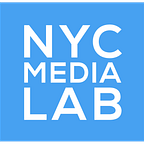Exploring Future Reality
AR and VR Work at NYC Universities
New York City universities are leading the way in exploring virtual and augmented reality from technical and creative viewpoints. Researchers from fields as varied as computer science, journalism, and electrical engineering are adapting, evolving, and contributing to the future of these new mediums.
Ken Perlin, New York University, NYU Media Research Lab
Professor Perlin develops tools for visual communication. His work also focuses on making user interfaces more direct and intuitive. His lab is creating a library of symbols for a program that interprets and brings drawings to life. The program, called Chalktalk, is modeled on the simplicity of communicating with a chalkboard. Chalktalk is used within augmented and virtual reality environments.
Another product of Perlin’s lab is Holojam, an interactive, multiuser experience in which users engage with each other inside a virtual space. Participants are tracked using an Optitrack motion capture system and represented by an avatar that mirrors their movements in the space. The wireless, low profile system runs on Gear VR and was designed in Unity.
Bob Sacha, CUNY Graduate School of Journalism
Masters students at the CUNY Graduate School of Journalism employ cutting-edge and emerging technology for reporting and sharing the news. Bob Sacha, Tow Professor of Video Storytelling, experiments with new video technology in his Video Storytelling and Video Lab classes. “My job as a teacher is to get people to explore things and figure out ways to make them work, or not,” said Sacha. “The concept that the teacher knows everything is not a very good way to teach. The students will often figure out something that I hadn’t thought of.” It’s this spirit of open innovation that led Sacha to develop experiments in virtual reality.
YingLi Tian, CUNY, the Media Lab at City College of New York
Professor YingLi Tian directs the Media Lab at City College of New York. The lab is a hub for electrical engineering research on how computers can see the world, and is concerned with how humans interact with computers. Although the focus is on assistive and surveillance technology, many projects in development at the Media Lab focus on core technologies that can be broadly applied.
Some of the most important projects Professor Tian is working on involve recognizing hand gestures, the posture of the body, and facial gestures. All of these elements are important for human interaction in virtual and augmented reality environments. Students from the program have gone on to academic posts, product development roles and to work in the research labs of large companies.
Steven Feiner, Columbia University, Computer Graphics and User Interfaces Lab
Professor Steven Feiner has been researching augmented reality and computer vision in the Computer Graphics and User Interfaces Lab at Columbia University for decades. A current focus of the lab is augmented reality and how it facilitates skilled tasks in the real world, such as correctly aligning jet engine parts in an in-the-field repair. In some experiments they have found that people complete tasks in up to half the time using the augmented reality overlay. Graduates from the lab have gone on to work at Microsoft, Industrial Light & Magic, and in academia.
Kyle Li, Parsons School of Design
Kyle Li works with students developing multimedia storytelling experiences. He emphasizes finding the right medium for the story at hand, rather than shoehorning a project into a specific platform. His students have used Unity and Unreal to develop their projects. Li has studied the history of virtual reality devices from around the world. He has a Nintendo virtual reality device from the late ’80s, the Family Computer VR 3-D System, in his office for inspiration.
Debra Anderson, The New School for Public Engagement
Debra Anderson teaches a course on data and consumer research at the New School for Public Engagement. She is the co-founder of Datavized, a New-York City based immersive design studio working at the intersection of virtual reality and data visualization, where she is building data-driven and researched based approaches to immersive experiences. Anderson notes that one of the most important parts of teaching is giving students an opportunity to “form their own opinions around the context of what makes good data visualization and user experiences.”
Exploring Future Reality is a report brought to you by NYC Media Lab. Download a PDF of the full report here.
Continue to “Closing Thoughts” for this series.
Return to the Exploring Future Reality report homepage.
